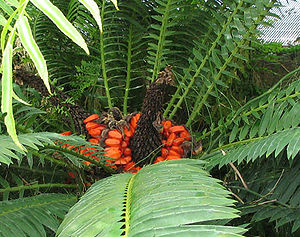Encephalartos lebomboensis
| Encephalartos lebomboensis | ||||||||||||
|---|---|---|---|---|---|---|---|---|---|---|---|---|

Encephalartos lebomboensis , plant with mature female cones |
||||||||||||
| Systematics | ||||||||||||
|
||||||||||||
| Scientific name | ||||||||||||
| Encephalartos lebomboensis | ||||||||||||
| IC Verdoorn |
Encephalartos lebomboensis is a species of cycads (Cycadales) from the genus of bread palm ferns ( Encephalartos ). The species is named after the Lebombo Mountains , from where it was first described . It is therefore also called Lebombo bread palm fern in German.
features
The trunks are rarely branched, often with root saplings at the base. They are up to 4 meters high and 25 to 30 cm wide. The crown is often slightly woolly. The cataphylls are densely hairy on the underside, bald on the top, long triangular, around 4 cm long and 1 cm wide at the base.
The numerous leaves are spread out, the color ranges from light to dark green and is usually lighter on the underside. The leaves are 1 to 1.5 meters long, 20 to 27 cm wide, more or less straight, sometimes slightly curved back and down, flat or slightly keeled. The young leaves are densely hairy, but soon glabrous. The petiole is 3 to 10 cm long. The rachis is gold-green. The basal leaflets are reduced to thorns . The middle leaflets are 12 to 18 cm long, lanceolate and 12 to 22 mm wide. They stand out at right angles and overlap. The leaf margin is thickened and usually covered with one to four thorns.
The female cones are solitary, rarely in pairs. They are upright, egg to barrel-shaped, 40 to 45 cm long and 20 to 25 cm in diameter. The color is greenish yellow. The stem is very short so that the cone appears seated. The sporophylls are 5.5 to 6 cm long. The side of the sporophyll lying on the surface of the cones is 35 to 45 mm high, 45 to 55 mm wide, flat and smooth, green-yellow to pale cream-colored. The sarcotesta of the seed is scarlet at maturity. The sclerotesta is 26 to 30 mm long, 18 to 20 mm in diameter, light brown and smooth, with the exception of 11 to 14 distinct longitudinal ribs.
The male cones are solitary, rarely in pairs. They are cylindrical and 40 to 45 cm long with a diameter of 10 to 13 cm. The color is apricot yellow to pale yellow. The stem is 1 to 3 cm long and 3 to 4 cm wide; the cone usually appears seated. The sporophylls are 3 to 3.5 cm long. The side of the sporophyll lying on the cone surface is 15 mm high and 35 to 40 mm wide; it rises in a pyramidal shape 1 to 1.5 cm high. In the upper part of the cone they are slightly hairy brown. The sporangia stand in a spot on the underside, with a recess on the outside.
Distribution and locations
The species occurs in South Africa , Mpumalanga Province in the Pongola Valley and in the upper catchment area of the Pongola and Pivaan rivers . In Swaziland it grows in the north of Siteki in the Kangwane area . It grows on steep, rocky slopes in sparse vegetation. The areas have 625 to 750 mm of precipitation annually, which falls mostly in summer, hot summers, cool winters with frequent fog.
Since there are only two populations of this species, which are not very large, it is classified as endangered.
Botanical history and systematics
The closest related species are Encephalartos altensteinii and Encephalartos natalensis . It was already suspected in the 1920s that it could be a separate species. Field studies confirmed these assumptions and in 1949 the species was first described by Inez Clare Verdoorn . In the 1990s it turned out that the type specimen belongs to a special, long-known form, the Piet Retief form, and forms its own species. Thus the populations growing in the eponymous Lebombo Mountains had to be described as a new species and have been called Encephalartos senticosus since 1996 .
literature
- Loran M. Whitelock: The Cycads. Timber Press, Portland OR 2002, ISBN 0-88192-522-5 , p. 212 f.
Individual evidence
- ↑ Walter Erhardt among others: The great pikeperch. Encyclopedia of Plant Names . Volume 2, page 1387. Verlag Eugen Ulmer, Stuttgart 2008. ISBN 978-3-8001-5406-7
Web links
- Encephalartos lebomboensis on the Cycad Pages of the Royal Botanic Gardens Sydney.
- Encephalartos lebomboensis inthe IUCN 2013 Red List of Threatened Species . Listed by: Donaldson, JS, 2009. Retrieved April 28, 2014.
